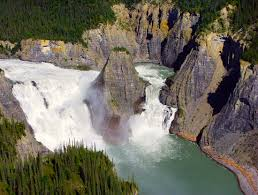Nahanni National Park Reserve, located in the Northwest Territories of Canada, is a breathtaking expanse of rugged wilderness that captivates adventurers and nature lovers alike. Renowned for its stunning landscapes, rich biodiversity, and deep cultural significance, Nahanni is a UNESCO World Heritage Site that offers an unparalleled experience for those seeking the beauty of the Canadian wilderness.
Established in 1976, Nahanni National Park was one of the first national parks in Canada. It is named after the Nahanni River, which flows through the park and has been a site of Indigenous significance for thousands of years. The Dene people have lived in the area for generations, and their cultural heritage is an integral part of the park's identity. The park was designated a UNESCO World Heritage Site in 1978, recognized for its outstanding natural beauty and geological significance.
Nahanni National Park is remote and primarily accessible by air or river. Most visitors arrive via charter flights from Fort Simpson or by taking guided river tours that begin in nearby towns. The Nahanni River is the main access route, making canoeing and rafting popular ways to explore the park.
1. River Adventures
The Nahanni River is the centerpiece of the park, offering thrilling white-water rafting and canoeing opportunities. Adventurers can embark on multi-day river trips, navigating through stunning canyons, waterfalls, and hot springs. Popular routes include:
- Virginia Falls: One of the most impressive waterfalls in North America, it drops 90 meters (300 feet) into the Nahanni River. The area around the falls is perfect for hiking and photography.
- The South Nahanni River: A UNESCO-designated waterway that provides breathtaking views and exciting rapids, ideal for both experienced and novice paddlers.
2. Hiking and Exploration
Nahanni offers numerous hiking opportunities for those looking to explore its stunning landscapes on foot:
- Liard Hot Springs: A short hike leads to these natural hot springs, providing a relaxing way to unwind after a day of adventure.
- Rabbitkettle Hotsprings: A unique geothermal area featuring fascinating formations and a chance to explore the surrounding wilderness.
3. Wildlife Viewing
The park is home to diverse wildlife, making it a haven for nature enthusiasts:
- Bighorn Sheep: Often seen on rocky slopes and cliffs.
- Moose and Caribou: Frequently spotted in the park’s forests and meadows.
- Birdwatching: The park is home to various bird species, including eagles, hawks, and songbirds.
4. Camping and Accommodations
While the park has limited infrastructure, visitors can find designated camping areas along the river and in more remote locations. For those seeking comfort, guided tours often include accommodations in tents or campsites along the river.
5. Cultural Experiences
Engage with the rich Indigenous history of the area through guided tours led by local Dene guides. Learn about traditional practices, stories, and the significance of the land to Indigenous peoples.
- Plan Ahead: Given its remote location, planning your trip in advance is essential. Check river conditions, weather forecasts, and available tours.
- Be Prepared: Pack essential gear, including camping equipment, food, water, and safety gear for river activities.
- Respect Wildlife: Maintain a safe distance from animals and follow park guidelines to protect both wildlife and yourself.
- Leave No Trace: Follow conservation principles to minimize your impact on this pristine wilderness.
Conclusion
Nahanni National Park is a true wilderness wonder that offers a unique blend of adventure, beauty, and cultural significance. Whether you’re rafting down the Nahanni River, hiking to stunning viewpoints, or soaking in natural hot springs, this remote park promises an unforgettable experience.


No comments:
Post a Comment